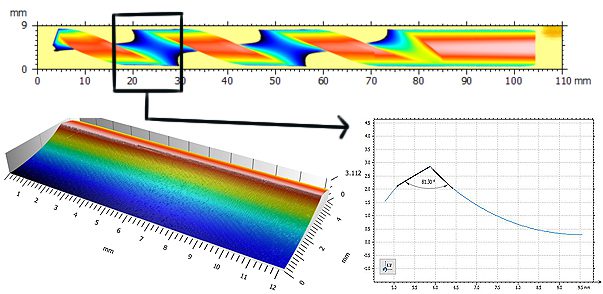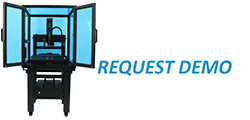
Medición del filo de la herramienta de corte en segundos
Irvine CA, 27 de julio de 2016 - La perfilometría convencional escanea las superficies de las muestras desde una única dirección fija. Esto solo es apropiado para medir muestras suficientemente planas, a diferencia de las formas cilíndricas que requieren una rotación precisa de 360°. Para una aplicación como la caracterización del borde de corte helicoidal de una herramienta, una máquina convencional necesitaría múltiples escaneos desde diferentes ángulos de toda la pieza, así como una importante manipulación de los datos después del escaneo. Esto suele llevar demasiado tiempo para las aplicaciones de control de calidad que sólo requieren mediciones de regiones muy específicas.
La platina rotacional de NANOVEA resuelve este problema con el control de movimiento simultáneo de los ejes lateral y rotativo. Esta técnica elimina la necesidad de medir toda la pieza y la realineación continua, que requiere mucho tiempo. En su lugar, la circunferencia completa de todo el borde de corte puede determinarse en segundos. Todos los ángulos y características deseados pueden determinarse directamente a partir del escaneado, sin necesidad de coser varios archivos.
La técnica confocal cromática de NANOVEA ofrece una resolución mucho mayor, de hasta 2,7 nm, y una mayor precisión que los competidores de la Variación de Enfoque. La altura bruta de la superficie se mide directamente a partir de la detección de la longitud de onda enfocada en la superficie, sin ninguno de los errores causados por las técnicas de interferometría, sin limitaciones de campo de visión y sin necesidad de preparar la superficie de la muestra. Los materiales con una reflectividad extremadamente alta o baja pueden medirse fácilmente y los ángulos de pared muy altos se caracterizan con precisión sin ningún problema.
Junto con el sensor de líneas de NANOVEA, se puede capturar una barra de datos de hasta 4,78 mm de ancho en una sola pasada, mientras se mueve linealmente hasta 150 mm en la dirección de exploración. Simultáneamente, la etapa de rotación puede hacer girar la muestra a la velocidad deseada. En conjunto, este sistema permite crear un mapa continuo de altura en 3D de toda la circunferencia de un borde de corte, con cualquier paso o radio, en una fracción de tiempo en comparación con otras tecnologías.
Véase la nota de la aplicación: Medición rotacional mediante perfilometría 3D









